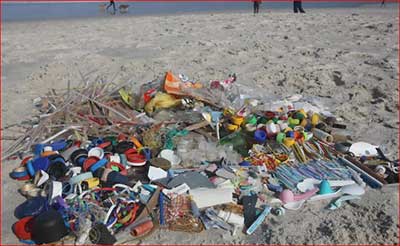Date: 25/03/2023
Relevance: GS-3: Economic Development, Biodiversity, and Environment.
Key Phrases: waste management, Central Institute of Petrochemicals Engineering & Technology (CIPET), durability, versatility, Microplastics, Extended Producer Responsibility (EPR), Swachh Bharat Abhiyaan.
Context:
- Plastic, a highly versatile polymer, has been an integral part of our lives for over a century now.
- However, the widespread use of plastic has resulted in significant environmental damage.
- Improper disposal of plastic waste pollutes air, water, and land, leading to serious long-term consequences.
Key Highlights:
- According to the Central Institute of Petrochemicals Engineering & Technology (CIPET), the packaging industry is responsible for approximately 24% of plastic generated in India.
- The global recycling rate for plastic is only 9%, and even in the US, it is a mere 4%, while India recycles around 13% of its plastic waste.
- One of the primary reasons for the low recycling rate is the lack of proper segregation of plastic waste at the local community level.
- Despite several attempts in the past, segregation of plastic at the household level has remained largely unsuccessful.
Do You Know?
- Plastic is a synthetic material made from a wide range of organic polymers that can be moulded into various shapes and forms when heated or melted.
- These polymers are typically derived from petroleum, although some plastics are also made from renewable materials such as cornstarch or sugarcane.
- Plastics are known for their durability, versatility, and low cost, which make them widely used in various applications such as packaging, construction, electronics, and transportation.
- An example of common biodegradable plastic is Polyhydroxyalkanoates (PHAs).
Why plastic is becoming a problem nowadays?
- Persistence:
- Plastic can persist in the environment for hundreds of years, and much of the plastic ever produced still exists in some form today.
- This means that even if we stop producing new plastic, the plastic that has already been released into the environment will continue to cause problems.
- Single-use items:
- Many plastic products are designed for single use, such as straws, utensils, and packaging, which means they are discarded after one use.
- This has led to a massive increase in plastic waste, which often ends up in landfills, oceans, and other natural habitats.
- Inadequate waste management:
- Proper waste management practices, such as recycling and proper disposal, are not available or accessible in many parts of the world, leading to plastic waste being dumped in the environment.
- Microplastics:
- As plastic breaks down into smaller and smaller pieces, it can create microplastics that can enter the food chain and harm wildlife and ecosystems.
- Environmental impact:
- Plastic pollution can harm wildlife, damage ecosystems, and contribute to climate change.
Steps to Reduce the Menace of Plastic:
- Reduce plastic consumption:
- The most effective way to stop the menace of plastic is to reduce our consumption of it.
- We can start by avoiding single-use plastics like straws, plastic bags, and disposable cutlery, and using reusable alternatives instead.
- Recycle and dispose of plastic properly:
- Proper waste management is crucial to reducing plastic pollution.
- We can recycle plastic materials whenever possible, and dispose of them properly in designated bins or recycling centers.
- Support legislation:
- Governments can play a significant role in reducing plastic pollution by implementing policies and regulations to reduce plastic production and use, and to incentivize recycling and sustainable alternatives.
- Support eco-friendly alternatives:
- We can support companies that are using sustainable materials and practices, and choose eco-friendly products whenever possible.
- Spread awareness:
- Raising awareness about the problem of plastic pollution and its impact on the environment can help people make more conscious decisions about their plastic consumption and waste management practices.
- Clean-up activities:
- Organizing and participating in clean-up activities in our communities, parks, and beaches can help reduce the amount of plastic waste that ends up in the environment.
Various Steps Taken by the Government :
- Plastic Waste Management Rules (2016): The Indian government has implemented comprehensive rules for plastic waste management, which include measures such as prohibiting the use of plastic bags thinner than 50 microns, promoting the use of compostable plastics, and mandating the establishment of plastic waste management systems.
- Ban on single-use plastics: Several states in India have implemented bans on single-use plastics such as plastic bags, cutlery, and straws.
- Swachh Bharat Abhiyaan: The Swachh Bharat Abhiyaan, or Clean India Mission, is a national campaign launched by the Indian government to promote cleanliness, hygiene, and sanitation. As part of the campaign, the government has focused on reducing plastic waste and promoting proper waste management practices.
- Extended Producer Responsibility (EPR): The Indian government has mandated EPR for plastic manufacturers and importers, which means they are responsible for collecting and disposing of the plastic waste generated by their products.
- Plastic Waste-Free Villages: The Indian government has launched the Plastic Waste-Free Village initiative, which aims to promote sustainable waste management practices and reduce plastic waste in rural areas.
- Promotion of alternatives: The Indian government has been promoting the use of eco-friendly alternatives to plastic, such as cloth bags, jute bags, and paper bags, through various campaigns and initiatives.
Conclusion:
- Plastic is not the problem, it is how we use and dispose of it that causes the damage.
- By adopting a circular economy model and increasing the awareness and participation of consumers, manufacturers, and local communities, we can make a significant impact towards a sustainable and cleaner future.
Source: The Hindu BL
Mains Question:
Q. "Plastic is not the problem, we are." Analyze the statement in the context of the environmental impact of plastic and the need for responsible use and recycling of plastic. (250 Words).







